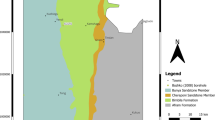Abstract
Groundwater recharge is an important process in hydrological water balancing where the conservational activity of both surface and subsurface water wealth is indispensable. The present geostatistical study deals with the identification of groundwater productive potential regions of Tirunelveli taluk in the Tirunelveli district of southern Tamil Nadu, India. The surface and subsurface morphological parameters such as geomorphology, lineament density, drainage density, topographic slope, land use/landcover, annual mean rainfall, soil, and subsurface geology were considered as groundwater influencing parameters and those are rejuvenated as thematic layers over the study area for inferring groundwater recharge potential regions. These thematic layers were extracted from the spatial and non-spatial datasets which were collected and downloaded from various sources. The satellite data products like LANDSAT-8, ASTER DEM, and existing published maps such as a geological map from the Geological Survey of India (GSI), topographic maps from Survey of India (SOI), and soil atlas from European digital archives are coming under spatial data categories. The non-spatial data of this study are daily rainfall data, monthly water level data, etc. In this study, the multi-criteria decision-making statistical analytical hierarchical process (AHP) methodology is utilized to achieve the layer weights. These weighted layers are reclassified by assigning ranks according to its relative importance, and those layers are mathematically overlaid for generating groundwater productive potential index map. The indexed groundwater recharge potential maps are reclassified into four classes such as very high, high, moderate, and low recharge potential region based on the cumulative score index (CSI) statistical approach and statistical information of the resultant index map. The net result reveals that around 104.25 km2 of the study area comes under the very high potential for groundwater infiltration region. The moderate and low potential regions are situated in the central and middle-eastern part of the study area which covers 49 % of the entire study area.















Similar content being viewed by others
References
Agarwal E, Agarwal R, Garg RD, Garg PK (2013) Delineation of groundwater potential zone: an AHP/ANP approach. JEarth Syst Sci 122(3):887–898
Amer R, Sultan M, Ripperdan R, Ghulam A, Kusky T (2013) An integrated approach for groundwater potential zoning in shallow fracture zone aquifers. Int J Rem Sens 34(19):6539–6561. doi:10.1080/01431161.2013.804221.
Anbazhagan S, Ramasamy SM (2006) Evaluation of areas for artificial groundwater recharge in Ayyar basin, Tamil Nadu, India through statistical terrain analysis. Journal of Geological Society of India. vol.67. Jan 2006:59–68
CGWB (2009) Central Groundwater Board district groundwater brochure Tirunelveli District, Tamilnadu, 1-21
Elmahdy SI, Mohamed M (2013) Groundwater potential modelling using remote sensing and GIS: a case study of the Al Dhaid area. U Arab Emirates Geocarto Int 29:433–450
Elmahdy SI, Mohamed MM (2014) Probabilistic frequency ratio model for groundwater potential mapping in Al Jaww plain, UAE. Arab J Geosci 8:2405–2416
Elmahdy SI, Mohamed MM (2015) Groundwater of Abu Dhabi Emirate: a regional assessment by means of remote sensing and geographic information system. Arab J Geosci 8:11279–11292
Jha MK, Chowdary VM, Chowdhury A (2010) Groundwater assessment in Salboni Block, West Bengal (India) using remote sensing, geographical information system and multi-criteria decision analysis techniques. Hydrogeol J 18:1713–1728
Kaliraj S, Chandrasekar N, Magesh NS (2013) Identification of potential groundwater recharge zones in Vaigai upper basin, Tamil Nadu, using GIS-based analytical hierarchical process (AHP) technique. Arab J Geosci 7. doi:10.1007/s12517-013-0849-x.
Machiwai M, Rangi N, Sharma A (2014) Integrated knowledge- and data-driven approaches for groundwater potential zoning using GIS and multi-criteria decision making techniques on hard-rock terrain of Ahar catchment, Rajasthan, India. Environ Earth Sci. doi:10.1007%2Fs12665–014-3544-7
Nag SK, Ghosh P (2012) Delineation of groundwater potential zone in Chhatna Block, Bankura District, West Bengal, India using remote sensing and GIS techniques. Environ Earth Sci 70:2115–2127
Prasad RK, Mondal NC, Banerjee P, Nandakumar MV, Singh VS (2007) Deciphering potential groundwater zone in hard rock through the application of GIS. Environ Geol 55:467–475
Saaty TL (1980) The Analytic Hierarchy Process. McGraw-Hill, New York
Saaty TL (1990) An exposition of the AHP in reply to the paper “Remarks on the Analytic Hierarchy Process”. Manag Sci 36:259–268
Samson S, Elangovan K (2015) Delineation of groundwater recharge potential zones in Namakkal District, Tamilnadu, India using remote sensing and GIS. J Indian So Remote Sensing 43(4):769–778
Saraf AK, Chowdhury PK (1998) Integrated remote sensing and GIS for groundwater exploration and identification of artificial recharge sites. Int J Rem Sen 19(10):1825–1841
Selvam S, Magesh NS, Chidambaram S, Rajamanickam M, Sashikkumar MC (2015) A GIS based identification of groundwater recharge potential zones using RS and IF techniques: a case study in Ottapidaram taluk, Tuticorin district, Tamil Nadu. Environ Earth Sci 73(7):3785–3799
Shekhar S, Pandey AC (2014) Delineating of groundwater potential zone in hard rock terrain of India using remote sensing, geographical information system (GIS) and analytic hierarchy process (AHP) techniques. Geocarto International
Acknowledgments
The authors wish to express sincere thanks to the Regional office of Anna University, Tirunelveli, for providing all necessary institutional support. They also acknowledge PWD, Government of Tamil Nadu, for providing necessary data.
Author information
Authors and Affiliations
Corresponding author
Rights and permissions
About this article
Cite this article
Kirubakaran, M., Johnny, J.C., Ashokraj, C. et al. A geostatistical approach for delineating the potential groundwater recharge zones in the hard rock terrain of Tirunelveli taluk, Tamil Nadu, India. Arab J Geosci 9, 382 (2016). https://doi.org/10.1007/s12517-016-2419-5
Received:
Accepted:
Published:
DOI: https://doi.org/10.1007/s12517-016-2419-5




